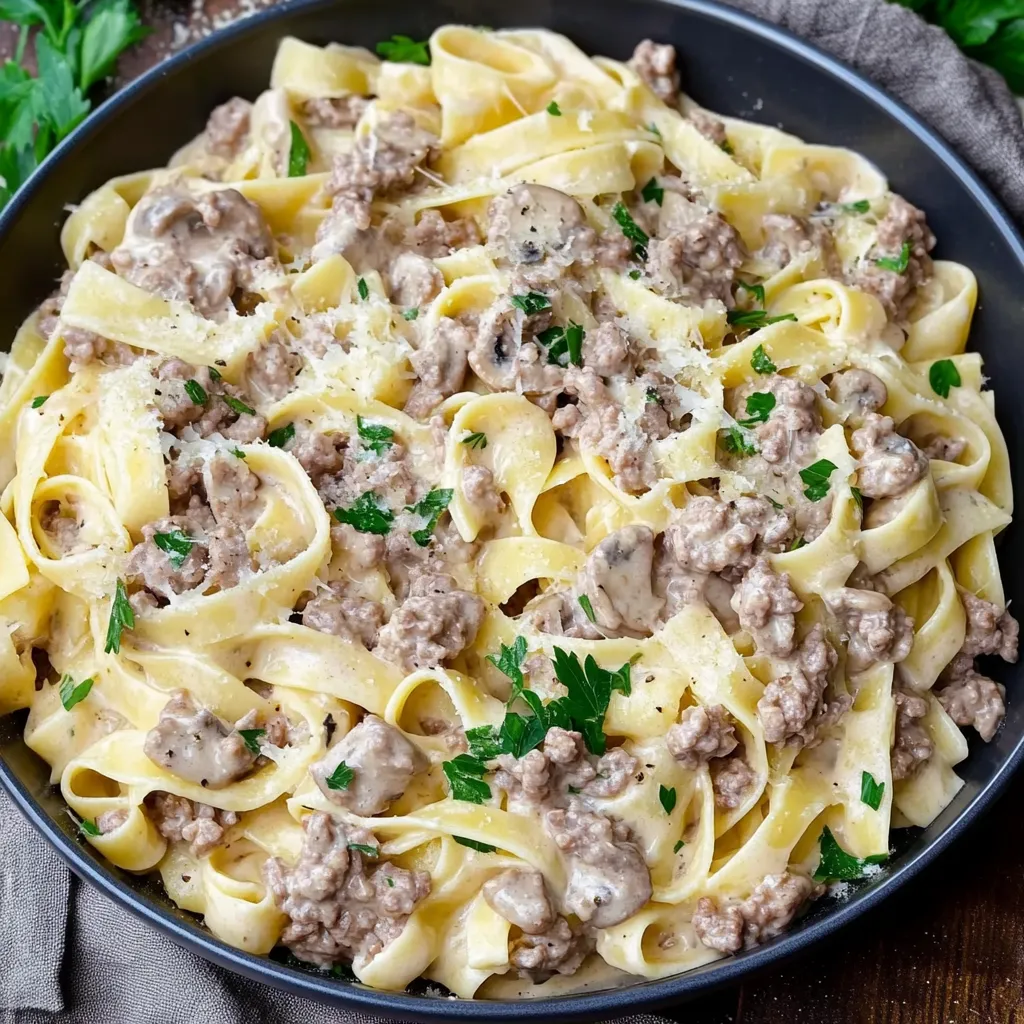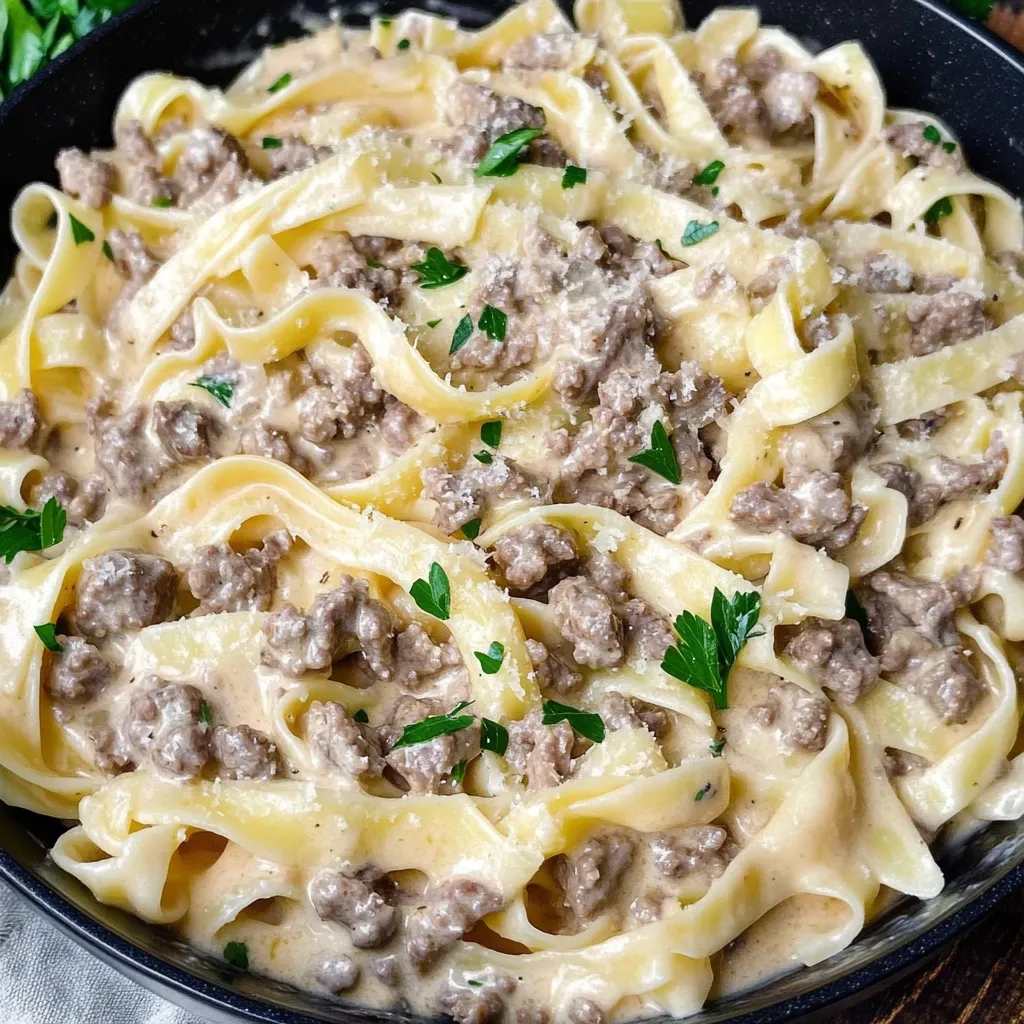 Pin it
Pin it
This incredibly satisfying ground beef alfredo transforms a simple weeknight dinner into restaurant-quality comfort food that delivers rich, creamy indulgence while remaining surprisingly approachable for home cooks of any skill level. The genius of this recipe lies in how it builds complex flavors through proper technique - browning the beef to develop fond, deglazing with wine to capture those caramelized bits, and finishing with cream and cheese to create a luxurious sauce that clings perfectly to every strand of pasta. Unlike heavy, one-dimensional alfredo dishes that can feel cloying, this version achieves perfect balance through the savory depth of well-browned meat, earthy mushrooms, and bright acidity from wine that cuts through the richness while maintaining that signature creamy satisfaction.
I created this recipe when I wanted to elevate basic alfredo beyond the typical butter-and-cheese version into something that felt like a complete, satisfying meal. The first time I made it, my family was amazed by how much more interesting and flavorful it was than standard alfredo, and now it's become our go-to comfort food when we want something that feels indulgent but doesn't require advanced cooking skills or exotic ingredients.
Essential Ingredients and Selection Tips
- 80-85% lean ground beef: This fat ratio provides optimal flavor without creating greasy sauce; leaner beef lacks richness while fattier creates oil separation
- Fresh mushrooms: Use white button or cremini mushrooms sliced uniformly for even cooking; avoid pre-sliced versions that dry out quickly
- Dry white wine: Choose crisp varieties like Pinot Grigio or Sauvignon Blanc for acidity that balances richness; avoid sweet wines that throw off flavor balance
- Heavy cream: Use real heavy cream (36% fat) for proper texture; half-and-half or milk substitutes won't create the same luxurious consistency
- Fresh Parmesan cheese: Grate your own from a wedge for superior melting and flavor; pre-grated cheese contains anti-caking agents that prevent smooth melting
- Low-sodium chicken stock: Choose quality stock for depth without excess salt; homemade stock creates even richer results
- Fresh aromatics: Use fresh garlic and onion rather than powdered for proper flavor development and aromatic foundation
The secret to restaurant-quality results is properly browning the beef to develop fond, then deglazing to capture those caramelized flavors in the final sauce.
Detailed Step-by-Step Instructions
- Step 1: Start the pasta water:
- Fill a large pot with salted water and bring to a rolling boil. Salt the water generously - it should taste like seawater for properly seasoned pasta.
- Step 2: Cook pasta perfectly:
- Add fettuccine to boiling water and cook according to package directions until al dente. Reserve 1 cup pasta water before draining - this starchy liquid is crucial for sauce consistency.
- Step 3: Build the flavor base:
- Heat olive oil in a large skillet over medium-high heat. Add diced onion and sliced garlic, cooking for 3-4 minutes until softened and fragrant.
- Step 4: Brown the beef properly:
- Add ground beef to the skillet, breaking it apart with a spoon. Cook for 4-5 minutes until well-browned with no pink remaining. Don't rush this step - proper browning creates flavor depth.
- Step 5: Add mushrooms strategically:
- Add sliced mushrooms to the skillet and cook until they release their liquid and begin to brown, about 4-5 minutes. The mushrooms should shrink and develop color.
- Step 6: Deglaze for flavor:
- Pour in white wine and scrape up any browned bits from the bottom of the pan using a wooden spoon. These fond bits add incredible flavor to the final sauce.
- Step 7: Build the sauce base:
- Stir in chicken stock and Italian seasoning. Bring to a simmer and cook for 2-3 minutes to reduce slightly and concentrate flavors.
- Step 8: Add cream carefully:
- Reduce heat to low and stir in heavy cream. Keep at a gentle simmer to prevent curdling - high heat will cause the cream to separate and ruin the texture.
- Step 9: Combine pasta and sauce:
- Add the drained fettuccine to the sauce and toss thoroughly to coat every strand. The pasta should be completely coated and integrated with the sauce.
- Step 10: Finish with cheese and pasta water:
- Add grated Parmesan cheese and enough reserved pasta water to achieve perfect consistency. The sauce should cling to the pasta without being too thick or too thin.
 Pin it
Pin it
The most important technique is maintaining gentle heat once the cream is added - high temperatures will cause curdling and ruin the silky texture.
This ground beef alfredo has become my evidence that comfort food can be both indulgent and thoughtfully prepared, proving that understanding proper technique elevates simple ingredients into something truly special.
Understanding Fond Development and Flavor Building
The browning process creates fond - those caramelized bits stuck to the pan bottom that contain concentrated flavor compounds developed through the Maillard reaction. Proper browning requires adequate heat and avoiding overcrowding, which creates steam instead of browning. The deglazing step with wine dissolves these flavor compounds and incorporates them into the sauce, creating depth that can't be achieved through other methods.
Cream Sauce Science and Temperature Control
Heavy cream contains proteins and fats that must be heated gently to prevent curdling. High temperatures cause proteins to coagulate rapidly, creating grainy texture instead of smooth creaminess. The key is maintaining gentle heat and gradual temperature changes, allowing the cream to warm slowly and integrate smoothly with other ingredients. Understanding this science prevents common alfredo failures.
Pasta Water Integration and Sauce Consistency
Starchy pasta water acts as both a thickening agent and an emulsifier, helping create smooth sauce consistency that clings properly to pasta. The starches released during pasta cooking help bind the sauce components together while the salted water adds seasoning throughout. Adding pasta water gradually allows precise consistency control without over-thinning the sauce.
Cheese Melting and Incorporation Technique
Freshly grated Parmesan melts more smoothly than pre-grated cheese because it lacks anti-caking agents that interfere with proper melting. Adding cheese off heat or at very low temperatures prevents the proteins from seizing and creating stringy or grainy textures. The residual heat from the pasta and sauce provides enough warmth for smooth melting when done properly.
Wine Selection and Acidity Balance
Dry white wine provides crucial acidity that cuts through the richness of cream and cheese while adding complex flavor notes. The alcohol cooks off during simmering, leaving behind concentrated flavor compounds and acids that brighten the overall dish. Choosing wines with good acidity ensures proper balance rather than just adding alcohol flavor.
This ground beef alfredo has taught me that the most satisfying comfort foods are those that balance richness with technique, proving that understanding why certain steps matter allows home cooks to create restaurant-quality results while maintaining the approachable, comforting nature that makes these dishes so beloved. Every time I make it, I'm reminded that the best family recipes are those that combine indulgence with accessibility, creating meals that bring people together around the table while delivering genuine satisfaction.
Frequently Asked Questions
- → Can I use a different type of pasta?
- Yes, you can use penne, rigatoni, or any pasta that holds sauce well. Just cook according to package directions.
- → What can I substitute for heavy cream?
- You can use half-and-half or whole milk, but the sauce won't be as thick. Add a tablespoon of flour to help thicken it.
- → How do I store leftover alfredo?
- Keep leftovers in the fridge for up to 3 days. Reheat gently on the stove with a splash of milk or pasta water.
- → Can I make this without wine?
- Absolutely! Just skip the wine and use extra chicken broth instead. The flavor will still be delicious.
- → What ground meat works best?
- Ground beef with 80/20 fat ratio works perfectly. You can also use ground turkey or Italian sausage for different flavors.
